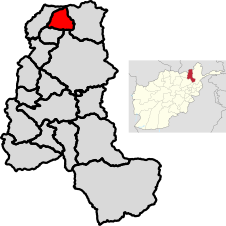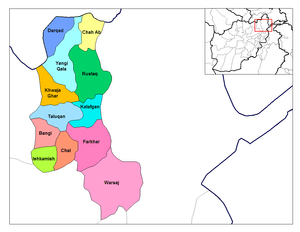Yangi Qala District
Yangi Qala District is a district in Takhar Province, Afghanistan. Economically the population of this district is primarily involved in agriculture. The main crops are rice and wheat, and the surplus rice is exporting to neighboring districts and provinces. On September 10, 2019, the district was taken the Taliban.[4] 3 days later, the district was of militants cleared in an operation.[5] There are 64 villages in the district.[1]
Yangi Qala District | |
|---|---|
 Location of the district in Takhar Province | |
| Coordinates: 37.47°N 69.62°E | |
| Country | |
| Province | Takhār Province |
| Area | |
| • Total | 247 km2 (95 sq mi) |
| Population (2015)[2] | |
| • Total | 23,959 |
| • Density | 97/km2 (250/sq mi) |
| Time zone | UTC+4:30 (Afghanistan Standard Time) |
| Post Code | 3766[3] |
The district is made up of several different ethnic groups.[6]
Geography
Yangi Qala has an area of 247 square kilometers, comparatively equivalent to Malta.[7] The district lies within the watershed of the Ab-i Rustaq River, a tributary of the Panj River.[8] There is a primary road going from the district center to the Khwaja Bahauddin District center, continuing to the Dashti Qala District center and ending by the district center in Khwaja Ghar District.[9]
The district borders Chah Ab District to the east, Rustaq District to the southeast, Khwaja Bahauddin District to the southwest, Darqad District to the west, and Khatlon to the north. All bordering districts are located in Takhar province, Afghanistan except for Khatlon, which is a Tajik province.[2][10] The Panj River separates Yangi Qala from Tajikistan.[11]
History

Amanullah Khan, in the 1920s, tried to colonize the area with non-native groups. Pashto-speakers arrived in the area and clashed with the native Uzbeks and Tajiks.[6]
The district has formally existed since 1973 when Mohammed Ashraf plotted a map of 325 Afghan Districts. That set expanded to 329 by 1998, and Yangi Qala went unchanged.[12] However, in 2005, Khwaja Bahuddin was split from this district and Yangi Qala shrank.[13]
Fighting
The first time that the Taliban were seen in the district was around 2009[14] and there have been clashes between Anti-government groups (including the Taliban) and the Government of Afghanistan.
In August 2010, anti-government forces established a checkpoint and captured one soldier and one policeperson.[15] Then in October, a NATO operation killed the Taliban district leader.[16] Three years later on 8 February 2013, ISAF captured an IMU leader who was assisting in planning a high-profile attack.[17] Later in 2015, the Taliban claimed to have taken the district, but officials said that was untrue.[18]
There was a clearing operation in the district in February 2017 that pushed the Taliban out of the district.[19] One month later, the Taliban claimed to have 15% control over the district.[20] The following May, the Taliban controlled almost half the districts and held a police checkpoint for more than a day.[21] Around this time, the decision was made to move the district offices to the provincial capital due to security concerns.[22] Later in September an attack on the district center was repulsed.[23] At the end of the year, the BBC classified Yangi Qala as having low Taliban presence, defined as being attacked about once every three months.[24]
On 6 February 2018, the Afghanistan Air Force raided Taliban strongholds in the district and killed 12 insurgents,[25] and another raid in May killed another 6 militants.[26] In October, Takhar officials said that the Taliban controlled half the district.[27] Around that same time, the Taliban attacked security outposts in the district.[28]
The Taliban took an outpost in Kaftar Ali village after two hours of fighting on 2 April 2019.[29] There was another attack on an outpost 32 days later.[30] Later in July, an illegal armed commander occupied a few villages in the district and disrupted activity.[31] There was another security post attack during that same month.[32] On 3 September, a pro-government militia was ambushed and 11 people were killed.[33]
Demographics
The district has a population of 23960, and half the population are males and the other half are females. The median age is 16.5 and 43.2% of people work in the district. 43.8% of those were seeking work but couldn't find any. The average household is 6.7 people, meaning there are about 3576 households in the district.[2]
Economy
More people work in agriculture than any other industry in Yangi Qala.[2] However, the farming technologies that the farmers have are not sufficient and there is a lack of irrigation systems. There are rug and carpet weaving centers in the district. The district doesn't have a proper center of trade.[1] Yangi Qala has one gold mine.[34]
The district exports heroin to Tajikistan.[35]
Healthcare and Education
Yangi Qala had about a 45% literacy rate for people ages 15–24 in 2015.[2] The district has some limited schooling opportunities including Madrasas, but the schools lack funds, staff, buildings, and supplies- leading to a low literacy rate. In addition, the district lacks a university.
There is some access to healthcare with three medical centers located in the district, however mortality rates remain high because of a lack of trained doctors, a district hospital, and safe drinking water.[1]
References
- "Summary of District Development Plan: Yangi Qala, Takhar province" (PDF). mrrd-nabdp.org. Retrieved 28 July 2020.
- "Takhar Socio-Demographic Economic Survey" (PDF). afghanistan.unfpa.org. UNFPA. September 2015. Retrieved 28 July 2020.
- "Yangi Qala Post Codes". worldpostalcode.com. Retrieved 28 July 2020.
- "Takhar's Yangi Qala District Falls To Taliban: Officials". TOLOnews. Retrieved 12 September 2019.
- TOLOnews (13 September 2019). "TOLOnews on Twitter". twitter.com.
- Djalili, Mohammad-Raza (1998). Tajikistan: The Trials of Independence. Routledge. p. 9. ISBN 0-7007-0420-5.
- "Island Directory Tables: Islands by Land Area". United Nations Environment Program. 18 February 1998. Retrieved 28 July 2020.
- "Part IV: Description of Watersheds" (PDF). aizon.org. p. 111. Retrieved 28 July 2020.
- "Takhar Maps Combined". nps.edu. AIMS. p. 14. Retrieved 28 July 2020.
- "Afghanistan Administrative Divisions" (PDF). aims.org.af. Retrieved 28 July 2020.
- "Yangi Qala". Google Maps. Retrieved 28 July 2020.
- "Afghanistan District Maps". maps.arcgis.com. Retrieved 29 July 2020.
- "398 District Division Matching to 329 District Division". aims.org. Retrieved 29 July 2020.
- Aryn Baker (8 July 2010). "The Making of a Taliban Commander". content.time.com. TIME. Retrieved 29 July 2020.
- "Security Situation Report, Week 33, 13 – 19 August 2010" (PDF). info.publicingelligence.net. UN Department of Safety and Security. August 2010. Retrieved 29 July 2020.
- CNN Wire Staff (7 October 2010). "In Afghanistan, troops kill Taliban militants". cnn.com. CNN. Retrieved 29 July 2020.
- Bill Roggio (11 February 2013). "2 IMU Leaders Captured in Northern Afghanistan". fdd.org. Federation for Defense of Democracies. Retrieved 29 July 2020.
- Pajhwok Report (29 September 2015). "Taliban claim capturing 2 Takhar districts". pajhwok.com. Pajhwok Afghan News. Retrieved 29 July 2020.
- "Two Districts of Takhar Province Were Cleared of Taliban Presence/". didpress.com. 27 February 2017. Retrieved 29 July 2020.
- Zabihullah Mujahid (26 March 2017). "Percent of Country under the control of Mujahideen of Islamic Emirate". alemarahenglish.com. Retrieved 29 July 2020.
- "Baseline Mobility Assessment Summary Results Afghanistan: June 2017" (PDF). afghanistan.iom.int. International Organization for Migration. June 2017. Retrieved 29 July 2020.
- Obaid Ali (29 July 2017). "The Non-Pashtun Taleban of the North (3): The Takhar case study". afghan-analysts.org. Retrieved 29 July 2020.
- ying (2 September 2017). "Afghan forces repulse Taliban attack on district, six attackers killed". xinuanet.com. Retrieved 29 July 2020.
- Shoaib Sharifi and Louise Adamou (31 January 2018). "Taliban threaten 70% of Afghanistan, BBC finds". bbc.com. BBC. Retrieved 29 July 2020.
- Chengcheng (6 February 2018). "Airstrikes kill 12 militants in N. Afghanistan". xinhuanet.com. Retrieved 29 July 2020.
- "6 militants killed in N. Afghan clash". xinuanet.com. 28 May 2018. Retrieved 29 July 2020.
- "Election in Takhar: Exasperation Towards Former MPs and Security Impediment". reporterly.net. 16 October 2018. Retrieved 29 July 2020.
- "Casualty Report". nytimes.com. New York Times. 26 October 2018. Retrieved 29 July 2020.
- "Casualty Report 4/4". nytimes.com. Retrieved 29 July 2020.
- "Casualty Report 5/9". nytimes.com. Retrieved 29 July 2020.
- Tamim Hamid (27 July 2019). "Casualties Reported Among Govt Forces In Ongoing Takhar Clashes". tolonews.com. TOLOnews. Retrieved 29 July 2020.
- "Casualty Report 8/1". nytimes.com. Retrieved 29 July 2020.
- "Casualty Report 9/5". nytimes.com. Retrieved 29 July 2020.
- "Jar-Bashi Mine, Yangi Qala District, Takhar, Afghanistan". mindat.org. 2002. Retrieved 28 July 2020.
- "Monitoring of Drug Flow in Afghanistan" (PDF). unodc.org. 2007. Retrieved 29 July 2020.